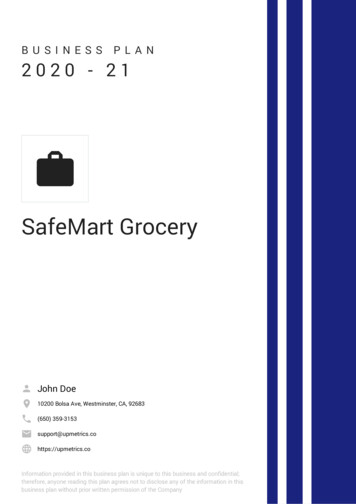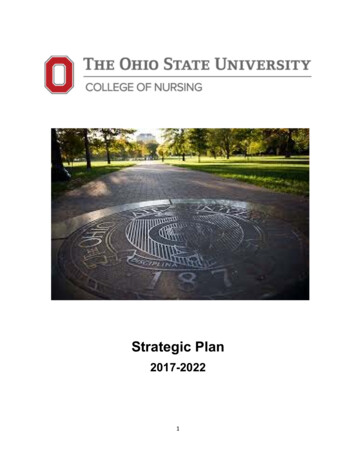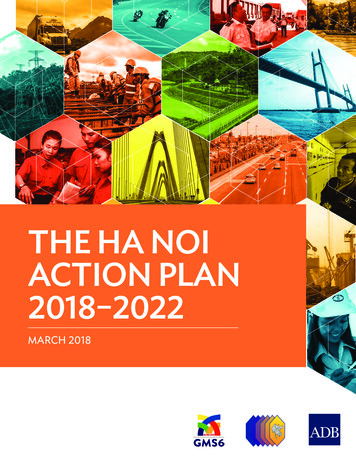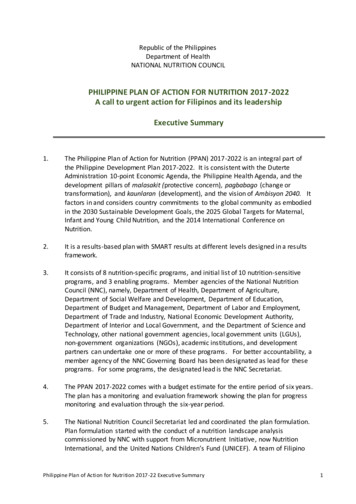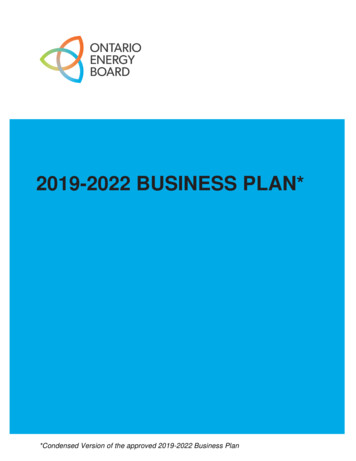
Transcription
2019-2022 BUSINESS PLAN**Condensed Version of the approved 2019-2022 Business Plan
Introduction & Executive SummaryIntroduction and Executive SummaryThe 2019-2022 Business Plan has been prepared in accordance with the Agencies &Appointments Directive (AAD) and the Guide to Developing Business Plans for ProvincialAgencies.It follows the strategic direction established in the OEB’s Strategic Blueprint: Keeping Pace withan Evolving Energy Sector – 2017-2022. Underlying that Strategic Blueprint is the simpleprinciple that regulation and regulated entities must deliver value to consumers.The Strategic Blueprint was first used to guide the development of the programs and activities inthe 2018-2021 Business Plan. Many of those programs and activities are still in progress and,accordingly, are carried forward in the current plan.Another important factor in the development of the 2019-2022 Business Plan has been the recentchanges in public policy that directly or indirectly impact the work of the OEB. These changes aredescribed more fully in the Environmental Scan. The OEB is confident that the particularprograms and activities set out in the current plan, together with the Strategic Blueprint, remainaligned with the broader policy framework in the province.Similar to the previous Business Plan, the programs and activities we are proposing for the threeyear planning period are organized around the Strategic Goals and Objectives and designed toaddress the four interconnected Strategic Challenges set out in our Strategic Blueprint:Transformation & Consumer Value – Utilities are delivering value to consumers in a changingenvironment.Innovation & Consumer Choice – Utilities and other market participants are embracinginnovation in their operations and the products they offer consumers.Consumer Confidence – Consumers have confidence in the oversight of the sector and in theirability to make choices about products and services.Regulation “Fit for Purpose” – The OEB has the resources and processes appropriate for thechanging environment.This Business Plan provides for the resources the OEB will need over the 2019-2022 planningperiod. The budget set out in this Business Plan is broadly consistent with those in the 2018-2021Business Plan.Stakeholders and intervenors also make a significant contribution to the work of the OEB, throughour ongoing adjudicative and policy consultation processes and through the formal advisorypanels and committees we have established.2
The Chair’s Advisory Roundtable (CAR), in particular, provided a range of industry and consumerperspectives on the key issues facing the sector and the OEB over the next three years. TheCAR’s input was very helpful in the development of this Business Plan.The OEB has adopted a range of measures to address and mitigate the risks we may encounterin carrying out the programs and activities identified in this Business Plan. Over the last year,there has been a modest increase in residual risk identified for two risk categories considered bythe OEB and its professional advisors, namely Government Policy & Oversight and InformationManagement. This Business Plan outlines the controls and measures that we will use to mitigatethese risks.We have also adopted a new outcomes-based Performance Measurement Framework. Thisinitiative will equip the OEB and others to gauge whether our regulation is achieving the intendedand desired outcomes in the Ontario energy sector.The OEB will continue to communicate with our key audiences, particularly energy consumers.3
Mandate, Vision, Mission & ValuesThe OEB’s Vision, Mission and Values are set out in our Strategic Blueprint. They complementour mandate and support a strategic direction that is centered on our role in ensuring thatregulated entities deliver value for all Ontario energy consumers.The OEB’s MandateThe OEB has regulated the natural gas sector since 1960 and the electricity sector since 1999.Our objectives, responsibilities and powers are set out in legislation, regulations and directives.For industry, we: Set the rates and prices that electricity and natural gas utilities can charge Monitor the financial and operational performance of utilities Approve major new electricity transmission lines and natural gas pipelines that serve thepublic interest Approve mergers, acquisitions and dispositions by electricity and natural gas transmittersand distributors Set the payments to be received by Ontario Power Generation in respect of its regulatednuclear and hydroelectric generation facilities Establish and enforce codes and rules to govern the conduct of utilities and other industryparticipants License entities in the electricity sector and natural gas marketersFor consumers, we: Protect their interests with respect to the rates and performance of their utilities Provide them with the information they need to better understand their rights andresponsibilities Protect their interests in retail electricity and natural gas markets Address the particular needs of low-income consumers in the context of utility customerservice rules and assistance programsIn addition, we play an important role as an independent and expert advisor to governmentregarding energy policy matters.These broad responsibilities and powers underlie our Vision, Mission and Values.The Vision sets out where the OEB wants our organization and the sector we regulate to be in thecoming years.4
The Mission sets out how we aim to achieve that Vision.The Values express our commitment about how we will conduct ourselves – both within our ownorganization and in our engagement with others.VisionThe OEB supports and guides the continuing evolution of the Ontario energy sector by promotingoutcomes and innovation that deliver value for all Ontario energy consumers.MissionWe will pursue this Vision by: Strengthening the focus on demonstrable consumer value during a period of sectorevolution Incenting and enabling innovation in a way that enhances consumer choice, control andvalue Strengthening and sustaining the confidence of consumers during a period of acceleratingchange Equipping our own organization to meet the challenges presented by sector evolutionValuesEffective – We hold ourselves to a high standard regarding the quality and efficiency of our workIndependent – We are objective and bring an open mind to all we doEngaged – We learn from our dialogue with consumers, utilities and other industry participantsExpert – We are experts in our field and share our knowledge with othersForward-looking – We support innovative solutions both within our own organization and bythose we regulateRespectful – We serve the public interest and treat everyone with respect5
Environmental ScanIn developing the 2019-2022 Business Plan, we considered key developments and trends in thebroader operating environment.Those developments and trends include, among others, accelerating technological innovation inthe production, delivery and use of energy, the redesign and “renewal” of Ontario’s wholesaleelectricity market, changes in consumer expectations regarding service quality and prices, and thedevelopment of new models for utility regulation.These particular matters were reviewed recently in the Strategic Blueprint and the 2018-2021Business Plan. Accordingly, that overview need not be repeated here. The discussion belowfocuses, instead, on three particular developments over the past year: Developments in legislation and public policy that may affect our mandate and work Recent changes regarding the ownership and consolidation of distributors andtransmitters in both the electricity and natural gas sectors Major OEB initiatives that will affect the design and execution of the programs andactivities set out later in this business planEach of these three matters is addressed in turn below.Developments in Legislation & Public PolicyThe OEB and the entities it regulates operate within a broader public policy environment that isparticularly dynamic. The extent and pace of change is reflected in the range of statutory andregulatory measures since the release of the 2018-2021 Business Plan. Those measures include:Prohibition Against the Purchase, Sale and Other Dealings with Emission Allowances and Credits(O. Reg 386/18) Prohibits the purchase, sale, trade or other dealing with emission allowances and creditsunder the cap and trade systemHydro One Accountability Act, 2018 (Bill 2) Establishes a framework to govern the amount of compensation for the directors, ChiefExecutive Officer and other executives of Hydro One Limited and its subsidiariesCap and Trade Cancellation Act, 2018 (Bill 4) Repeals the Climate Change Mitigation and Low-carbon Economy Act, 2016 Sets out the legal framework for the wind-down of the cap and trade program, including acompensation framework in respect of cap and trade instruments Requires the government to establish targets for reducing greenhouse gas emissions inOntario6
Access to Natural Gas Act, 2018 (Bill 32) Amends the Ontario Energy Board Act, 1998, to establish a new framework for therecovery through rates of costs incurred by a gas distributor in respect of eligible systemexpansion projectsGreen Energy Repeal Act, 2018 (Bill 34) Repeals the Green Energy Act, 2009 Re-enacts various provisions of the Green Energy Act, 2009 in the Electricity Act, 1998,including provisions regarding energy consumption reporting and the provision of energydata using specified technologiesNet Metering, (O. Reg.422/18) Revokes regulations regarding third-party ownership of qualifying net-metered renewablegeneration projects and the implementation of “virtual” net metering arrangements,pending the government’s broader review of energy policyRestoring Ontario's Competitiveness Act, 2018 (Bill 66) If passed as currently written, will repeal the authority of the OEB to approve what unitsub-meter providers can charge for unit sub-meteringPreserving and Protecting our Environment for Future Generations: A Made-in-OntarioEnvironment Plan The government’s proposed environment policy aims to protect the province’s air, landand water, address litter and reduce waste, support efforts to reduce greenhouse gasemissions, and help communities prepare for climate changeThe OEB expects further changes over the course of the planning period as the governmentdevelops and implements its broader energy policy.Among other things, the Modernization Review Panel that was announced in December 2017(and re-constituted in August 2018 under revised terms of reference) has submitted its report tothe government, but the government’s intentions regarding that report were not known at the timeof submission of this Business Plan.7
Changing Structure of the SectorThe Ontario electricity distribution sector continues to be characterized by significant diversityamong distributors relating to size, density, geographic footprint and investment requirements.The last year saw significant consolidation in that sector, including the OEB’s approval of thefollowing mergers and acquisitions: Entegrus Powerlines Inc. and St. Thomas Energy Inc. (March 15, 2018) Newmarket-Tay Power Distribution Ltd. and Midland Power Utility Corporation (August 23,2018) Acquisition by EPCOR Collingwood Distribution Corp. of the interest of the Town ofCollingwood in Collus Powerstream Corp. (August 30, 2018) Alectra Utilities Corporation and Guelph Hydro Electric Systems Inc. (October 18, 2018) Thunder Bay Hydro Electricity Distribution Inc. and Kenora Hydro Electric Corporation Ltd.(November 15, 2018) Erie Thames Powerline Corporation and West Coast Huron Energy Inc. (December 20,2018) Veridian Connections Inc. and Whitby Hydro Electric Corporation (December 20, 2018)Several other proposed mergers in the electricity distribution sector are pending before the OEB.The natural gas sector has also seen a major consolidation over the past year. In August 2018,the OEB approved the merger of Enbridge Gas Distribution Inc. and Union Gas Limited, the twolargest natural gas distributors in Ontario, subject to terms and conditions regarding rate-makingin the post-merger period. This merger follows the 2016 merger of Enbridge Inc. and SpectraEnergy Corp., the parent companies of Enbridge Gas and Union Gas, respectively.The OEB has also received several applications for the expansion of natural gas distributionservice to communities that currently have no access to natural gas. We anticipate that we willimplement any future gas expansion framework, including the processing of these applications asapplicable, once regulations are in place.The Independent Electricity System Operator (IESO) is taking steps to identify high-level designsfor the major elements of its market renewal initiative.8
Major OEB InitiativesOur programs and activities for the three-year planning period will build on a number of majorinitiatives that we have undertaken during 2018. Those initiatives, which are listed below, reflectour drive to be a more open, innovative and consumer-centric organization:Utility Performance: Gas Supply Planning – Improving our assessment of the natural gas supply plans ofnatural gas utilities to ensure that those plans meet the goals of cost efficiency andreliability. Cost Responsibility Rules – Proposing code amendments to allocate costs arising fromregional plans in a way that apportions the costs in respect of transmission connectioninvestments to transmission and distribution customers on the basis of benefit. Evaluation of Natural Gas Demand-Side Management – Conducting a mid-term reviewof the six-year conservation framework to assess the progress of the gas utilities towardstheir conservation targets and the effectiveness of their existing programs.Empowering the Consumer: Regulated Price Plan Pilots – Supporting a series of pricing pilots with residentialconsumers to test ways to give such consumers more control over costs and to helpimprove system eff
Appointments Directive (AAD) and the Guide to Developing Business Plans for Provincial Agencies. It . Requires the government to establish targets for reducing greenhouse gas emissions in Ontario. 7 Access to Natural Gas Act, 2018 (Bill 32) Amends the Ontario Energy Board Act, 1998, to establish a new framework for the recovery through rates of costs incurred by a gas distributor in respect .



